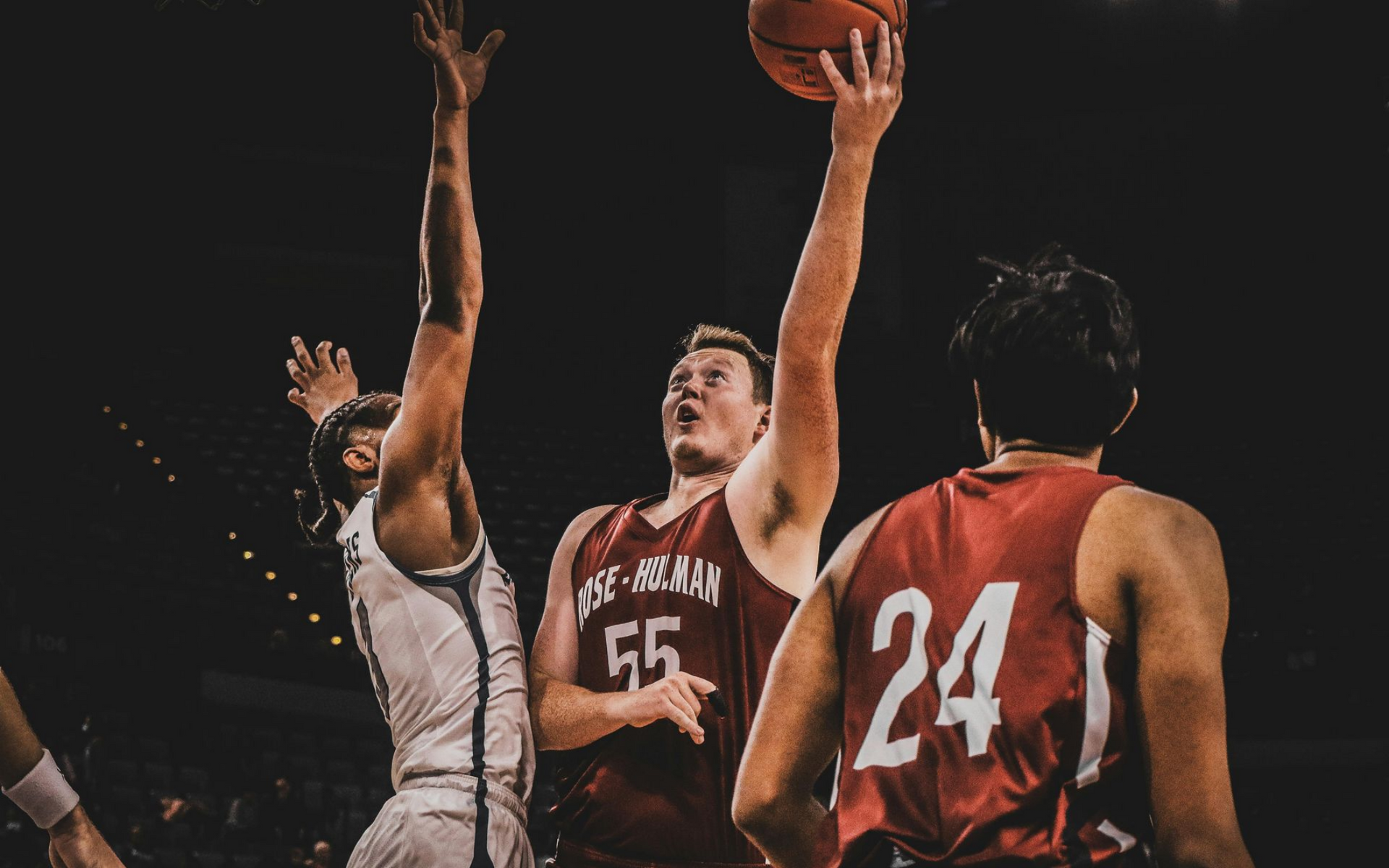The U.S. Student-Athlete Pathway — An Overview for International Students: The U.S. College Sports Landscape
Joseph Lennarz • November 6, 2025
Introduction
For many talented athletes around the world, U.S. college athletics represent a remarkable opportunity to combine elite athletic competition with higher education. In sports such as basketball, soccer, track and field, and tennis, among others, hundreds of colleges and universities across the United States offer structured programs that allow student-athletes to train at a high level while pursuing a fully accredited degree. This dual pathway is especially appealing to athletes who are not only gifted in their sport but also strong students with a passion for learning.
The collegiate athletics system provides access to world-class coaching, athletic facilities, support structure, and exposure to professional scouts, all within a framework that emphasizes academic achievement and personal development. Additionally, many of these colleges are able to offer some level of scholarship (meaning financial assistance) to their student-athletes based on athletic talent, academic merit, financial need, or some combination of those factors. This allows student-athletes, even from lower-resourced backgrounds, to be able to participate and thrive in collegiate athletics. College athletics are thus a great option to serve as both a launching pad to professional careers and a foundation for lifelong success beyond an athlete’s playing days.
The U.S. College Sports Landscape
College athletics in the United States are organized primarily under three governing bodies:
- NCAA (National Collegiate Athletic Association): The largest organization, divided into Divisions I, II, and III, each with its own academic and athletic eligibility standards.
- NAIA (National Association of Intercollegiate Athletics): Smaller, often offering greater scholarship flexibility and a more personal recruitment process.
- NJCAA (National Junior College Athletic Association): Oversees two-year colleges, frequently serving as a stepping stone to four-year programs.
Understanding these associations helps international athletes align their academic goals, athletic level, and immigration planning from the outset. In order to compete for a given college or university, you must be granted admission to the school as a student, be deemed eligible to participate with their athletic team in your sport, and have costs of attendance covered through your own resources, a scholarship, or a combination of both (which we will discuss more later in this series).
Each of these organizations has different standards for admission and student-athlete eligibility, and each offers a different type of athletic environment. For example, NCAA Division 1 programs offer the most competitive athletic environment, with the largest program budgets and highest number of graduates going on to careers as professional athletes in their respective sports, but they also have the strictest standards for admission and eligibility to compete as a student athlete. NAIA programs range in competitiveness, but generally have more relaxed admission standards and eligibility requirements than NCAA programs. NJCAA programs have a lower competition standard as well as more relaxed admission and eligibility standards; however, they are structured in a way that allows students who are initially ineligible for NCAA to become eligible and progress to that level after two years.
The best way to determine which level(s) you are eligible for, is to get in touch with some programs and discuss these requirements with them. It is common for college coaches to recruit student athletes from all over the world, so don’t hesitate to reach out to programs that you think might be a fit for you, even if they don’t already have athletes from your country on their roster. Many coaches have their email addresses listed on their school’s website, and will evaluate candidates who contact them directly. Make sure to include as much information about your academic background and playing career as possible, including highlights or match film and statistical data whenever possible. Keep in mind that a coach will likely be very busy during their sport’s designated competition season. Most college sports will compete during an autumn, winter, or spring season, so if possible, conduct your outreach when the season has ended and coaches have the time to start evaluating potential new recruits for next year.
Academic admission and athletic eligibility requirements can include various factors such as the following: overall grade averages and test scores, requirements for a student to have taken certain courses in their previous academic program(s), proof of English proficiency or certain score benchmarks in English proficiency tests such as TOEFL or Duolingo if English is not your native language, a maximum number of years since graduating from secondary school, or lack of experience at a professional level in the sport you will be competing in.
Tips on this part of your student-athlete journey:
- Focus on programs that fit your profile ->
understand what the requirements are for each level, and focus your search on programs within a league or division level that suit your background and your goals. If you are a strong student but less decorated athlete, consider an NCAA Division 2 or 3 program that might have great academic standards but a lesser standard to contribute in your sport. If you are an elite professional prospect in your sport, make sure the schools you focus on have a track record of producing professional players, and the standard is high enough to platform you for that level.
- Don’t be afraid to ask! -> If you are speaking to a coach about potentially coming to their program, ask them for clear and specific guidelines on what the requirements are for admission to their school and for eligibility to play for their program. They don’t want to waste their time on a recruit who won’t be able to play for them, any more than you want to waste your time on a program that won’t end up being a fit. Making sure that you check all the boxes from the beginning will help to cut down on chasing the wrong programs.
The one requirement that all American college athletic programs have in common, is that an international student athlete will require a valid F1 student visa in order to attend and compete.
If you are a talented non-American athlete who is interested in pursuing a college degree in the United States while also competing in your chosen sport, or even a current student athlete or college coach with questions relating to F1 student visas, you should consult with an immigration attorney to ensure that you are up to date on current rules and regulations.
This blog is not intended to be legal advice and nothing here should be construed as establishing an attorney client relationship. Please schedule a consultation with an immigration attorney before acting on any information read here.
Joseph Lennarz
Similar Posts

Once you have connected with a college program, have been admitted to the school, and deemed eligible to compete athletically, you will need to secure an F-1 student visa in order to actually attend your new college and begin your time as a student athlete. The first step in the visa process is to receive your Form I-2

The United States has long been a destination for the world’s most talented athletes—not only to compete at the highest level, but to access world-class training, coaching opportunities, and long-term career prospects. Whether on the field, in the ring, or across the chessboard, athletes from across the globe are finding immigration pathways that allow them to pursue their athletic and professional goals in the U.S. U.S. immigration law offers several visa and green card options designed specifically for individuals with extraordinary athletic talent. These include the P-1A visa for internationally recognized athletes, the O-1A visa for individuals of extraordinary ability, and the EB-1A immigrant petition, which can lead to permanent residency and ultimately, U.S. citizenship. The P-1A visa is commonly used by professional athletes coming to the U.S. to compete in a specific event or season. This applies not only to individual athletes but also to members of teams or clubs recognized internationally. It is widely used by soccer players, basketball players, MMA fighters, Brazilian Jiu-Jitsu competitors, and even elite chess players. Athletes must demonstrate a high level of international recognition and a record of performance in their sport. The O-1A visa is a strong option for coaches who demonstrate extraordinary ability, typically evidenced by championship titles, sustained winning records, or recognition as integral to their team’s success. To qualify, a coach must establish that their expertise places them among the small percentage of top professionals in their field. For athletes seeking permanent status in the U.S., the EB-1A immigrant petition —often referred to as the “extraordinary ability green card”—provides a direct path to lawful permanent residency. It requires clear documentation that the individual is among the very best in their sport and has achieved sustained national or international success. Unlike other green card categories, the EB-1A does not require employer sponsorship and can be self-petitioned. This has become a common path for MMA world champions, BJJ black belt medalists, Olympic athletes, and chess grandmasters—many of whom now represent the U.S. at the highest levels of international competition. It’s important to note that U.S. immigration law defines “athlete” broadly. Whether you are a professional football player in Europe, a sprinter from the Caribbean, a judoka, a gymnast, or a grandmaster in chess, your achievements may qualify under these categories if they are properly documented and presented. The key is a consistent record of excellence and recognition in your sport on a national or international scale. Our office specializes in these types of immigration matters. Whether you are an individual athlete looking to relocate or an organization seeking to bring international talent to your roster, we offer tailored legal strategies to support your goals. If you are exploring options to compete, train, or build your future in the U.S., we’re here to help you take the next step.

In a renewed wave of enforcement, U.S. Immigration and Customs Enforcement (ICE) has started sending formal alerts to certain F-1 students participating in Optional Practical Training (OPT), flagging that their records reflect over 90 days without any reported employment. These students have been advised to update their employment status in the Student and Exchange Visitor Information System (SEVIS) within 15 days. Failure to take timely corrective action may lead to the termination of the student's SEVIS record, effectively marking them as out of status, and may ultimately trigger removal proceedings. The notices are intended as a warning that students who do not comply with OPT reporting obligations are at risk of serious immigration consequences. Understanding OPT and Its Unemployment Limits Optional Practical Training (commonly referred to as “OPT”) is a work authorization benefit that allows eligible F-1 international students to gain hands-on experience in their field of study. Students may apply for pre-completion OPT (while still in school) or post-completion OPT (after graduation), typically for up to 12 months. Those with degrees in qualifying STEM fields may apply for an additional 24-month STEM OPT extension, giving them a total of 36 months of work authorization in the U.S. To maintain valid F-1 status while on OPT, students must remain actively employed in a position related to their field of study. The amount of time a student may remain in the United States while on OPT without being properly employed is capped at: 90 days during the standard 12-month post-completion OPT, and 150 days for those on the STEM OPT extension, which includes any days of unemployment accrued during the initial OPT period. These unemployment limits are cumulative and enforced strictly through SEVIS monitoring. What Should F-1 Students Do? If you are an F-1 student on OPT or STEM OPT and receive a warning or are unsure about your compliance status, act quickly: Contact your Designated School Official (DSO) immediately to review and, if necessary, update your SEVIS record. Ensure all employment is properly documented and reported through your school’s international office. Do not ignore warning notices, as failure to respond may lead to SEVIS termination and potentially the initiation of removal proceedings. It is also advisable to consult with a qualified immigration attorney to explore available options and understand how enforcement actions may affect your status or future immigration plans. If you received a notice or have questions about your F-1 status, our attorneys are here to help you take the right steps to protect your future in the United States. Contact us today to schedule a consultation.

According to the U.S. State Department, there has been a steady increase of F-1 visas issued for foreign students within the past year. In Fiscal Year 2022, 411,000 F-1 visas were issued, rising from the 358,000 F-1 visas issued in the 2021 Fiscal Year. These numbers have shown that F-1 student visas have recovered to pre-pandemic numbers. In 2020, only 111,000 F-1 student visas were issued due to pandemic uncertainty, border restrictions, embassy closures, and other barriers for students to study in the United States. The government expects these numbers to continue to rise even with rising rejection rates of F-1 applicants. In 2022, the U.S. State Department rejected 35% of all F-1 applicants in 2022, an increase from previous years. In addition, in May 2023, U.S. Immigration and Customs Enforcement terminated COVID-era guidance allowing F and M students to utilize more online classes toward a full course of study. The increasing F-1 student visas are a good sign for American employers because these individuals seek to study in the United States due to American excellence in wages, opportunity, diversity, and the encouragement of highly skilled workers. By assimilating in the United States through their education, they will be prepared to contribute to the United States workforce. For those who are interested in applying for the F-1 student visa, please contact our office for consultation and further information.

Once you have connected with a college program, have been admitted to the school, and deemed eligible to compete athletically, you will need to secure an F-1 student visa in order to actually attend your new college and begin your time as a student athlete. The first step in the visa process is to receive your Form I-2

Under the new regulation, if a person filed or files Form I-589, Application for Asylum and for Withholding of Removal after October 1, 2024, and the application remains pending with USCIS for 365 days, the applicant must pay an Annual Asylum Fee (AAF) on the one-year anniversary of his or her filing date.

It’s no secret that the U.S. immigration system has faced increased scrutiny and change in recent months. From evolving policies to headlines filled with uncertainty, it’s understandable that many individuals are left wondering: Is this still the right time to pursue a future in the United States? The answer is yes—and here’s why. Despite the shifting political landscape, the core structure of U.S. immigration law remains firmly in place. While the process may appear more complex or demanding than it once was, the legal pathways to live, work, and thrive in the United States are still open and accessible to those who take the proper steps. What often gets lost in the conversation is that the United States remains a country built on innovation, creativity, and resilience. It continues to attract global talent, entrepreneurs, artists, and professionals from all walks of life. Whether you are launching a business, advancing your career, or seeking a better life for your family, the United States offers unparalleled opportunities to those who are prepared and determined. Much of what makes the United States a global economic and technological leader today is the direct result of contributions made by immigrants. Nearly half of the current Fortune 500 companies were founded by immigrants or their children. Immigrant entrepreneurs have long been an essential part of America’s economic success story. Some of the largest and most recognizable American companies were founded by immigrants or the children of immigrants. This includes household names such as Apple and Costco. Moderna, the pharmaceutical company and vaccine producer, was founded by a Canadian-born stem cell biologist, Derrick J. Rossi, whose parents themselves emigrated from Malta. These success stories are not outliers; they are part of a broader pattern that reflects the drive, innovation, and resilience that immigrants bring to the country. The United States also offers one of the most dynamic and diverse economies in the world. It is a place where hard work, fresh ideas, and entrepreneurial vision are rewarded. For creative professionals, business leaders, and investors, the United States provides a unique platform to grow, connect, and gain global influence. Its competitive marketplace, access to capital, and culture of innovation create unmatched opportunities for those ready to seize them. While the immigration process requires careful planning, that process is far from impossible. Indeed, having strong legal guidance is one of the most effective advantages an applicant can possess. Immigration law is complex, and each case must be evaluated individually. A clear, strategic plan tailored to your background and goals can significantly improve your chances of success. What may feel like a hurdle at first glance is often navigable with solid preparation and documentation. At our immigration law firm, we have had the privilege of assisting individuals from all over the world as they navigate these complexities. Time and again, we have witnessed how determination, careful preparation, and experienced legal counsel can turn uncertainty into opportunity and help transform a vision for the future into reality. If you have been uncertain about whether to move forward, let this be your sign to take the next step. The United States is still a land of possibilities. If you are ready to take that step, now is the time to act. Let us build your path forward together.



